Prague

Home | Hamburg | Lauenberg | Tangermünde | Berlin | Wittenberg | Torgau | Meissen | Dresden | Saxony | Prague
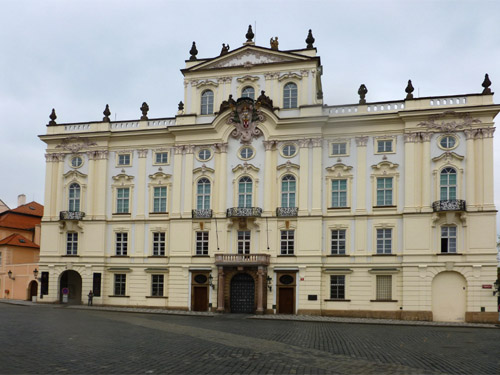 Our first full day in Prague began with a walking tour of the castle area. It was drizzling but we enjoyed such sights as the Archbishop's Palace in the square near the entrance to the Castle. It is in high baroque style, an example of one of the many types of architecture in Prague.
Our first full day in Prague began with a walking tour of the castle area. It was drizzling but we enjoyed such sights as the Archbishop's Palace in the square near the entrance to the Castle. It is in high baroque style, an example of one of the many types of architecture in Prague.
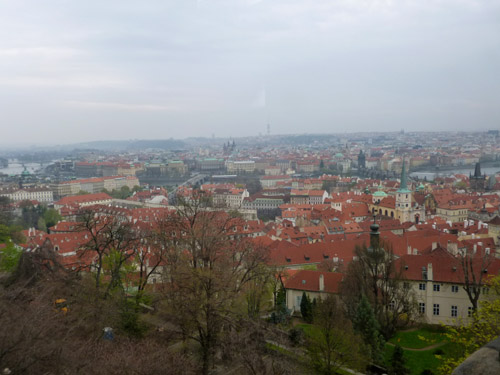 A look down on the city below. It is impressive in spite of the weather and shows why Prague is sometimes known as the city of 100 spires, although only a few can be seen in this photo.
A look down on the city below. It is impressive in spite of the weather and shows why Prague is sometimes known as the city of 100 spires, although only a few can be seen in this photo.
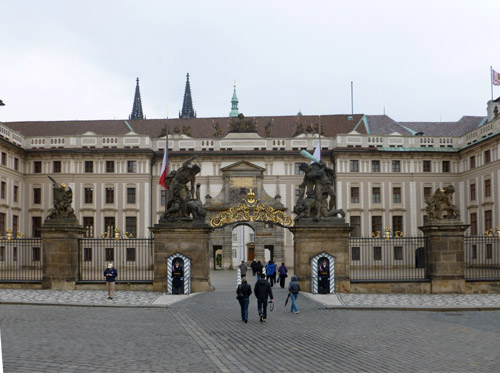 Turning in another direction, we see the entrance to the castle itself.
Turning in another direction, we see the entrance to the castle itself.
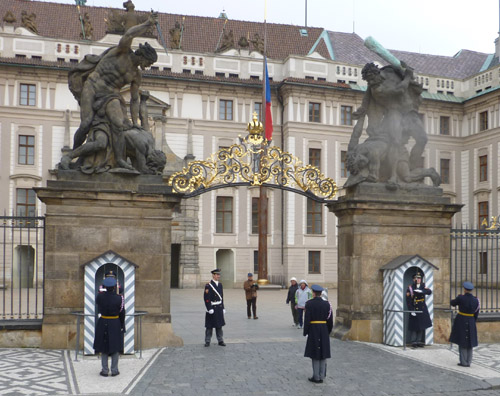 While our guide was telling us about the castle, there was a changing of the guard.
While our guide was telling us about the castle, there was a changing of the guard.
 As we entered one of the courtyards of the castle, we saw St. Vitus Cathedral, an excellent example of Gothic architecture and the biggest and most important church in the country. This is a front view of the cathedral and its rose window.
As we entered one of the courtyards of the castle, we saw St. Vitus Cathedral, an excellent example of Gothic architecture and the biggest and most important church in the country. This is a front view of the cathedral and its rose window.
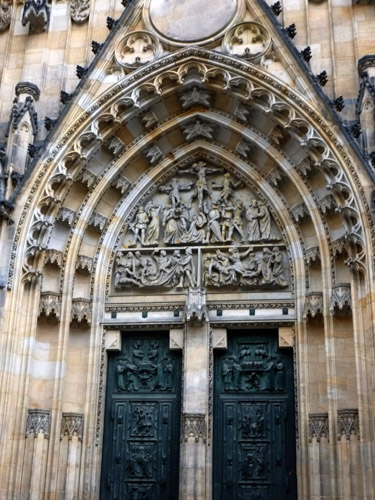 The main entrance with its bronze doors and the typical judgement scene above it.
The main entrance with its bronze doors and the typical judgement scene above it.
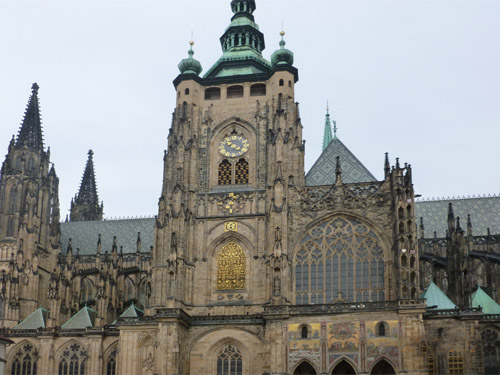 The uncompleted gothic main tower was finished as baroque.
The uncompleted gothic main tower was finished as baroque.
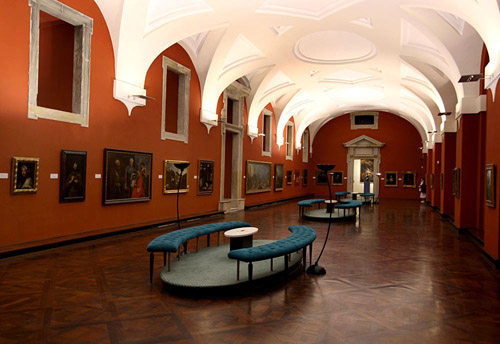
After looking around here a bit more, the rest of the group took the bus to the Old Town Square. Since it was a rainy day, Elizabeth and Don decided to stay at the castle and go to a couple of museums. We began in the Picture Galley of the Castle. The permanent exhibition here offers the best 107 paintings and 3 statues selected from over 4,000 works of art in possession of Prague Castle. Among the artists, whose works are on display in the Prague Castle Picture Gallery, are Titian, Rubens and many others.
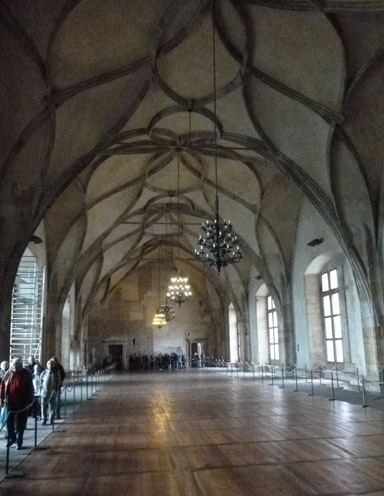
We next went into the Old Royal Palace. In it was the Vladislav Hall. From the 16th century it served particularly royal state purposes. It was the scene of coronation festivities and banquets, knights' tournaments and markets with artistic and luxurious goods. The Vladislav Hall still partly fulfils the state function: the elections of the president of the Czech Republic and ceremonial gatherings connected with important days in the life of this country take place in it.
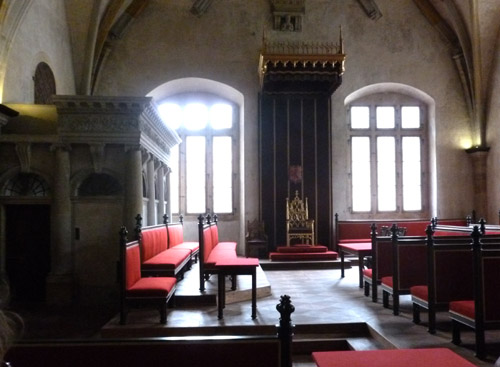
Next to the Vladislav Hall is the Diet Hall, which gives an idea of the way in which the proceedings of the Diet took place after 1627.
Another part of this musuem included an architectural history of the building of the palace.
Also in the palace complex was St. George's Basilica and Convent. There is an art museum in the convent but it was closed.


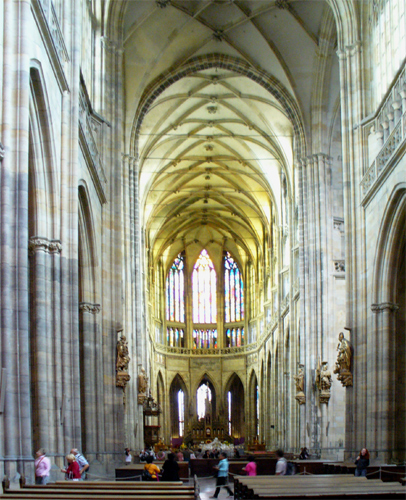 After some time the St. Vitus Cathedral opened its door and we were able to enter. The interior was breathtaking.
After some time the St. Vitus Cathedral opened its door and we were able to enter. The interior was breathtaking.
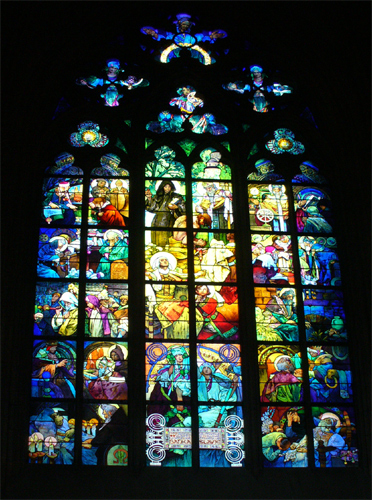 There were many beautiful stained glass windows but this is probably the best known, done by the famous Czech Art Nouveau painter Alfons Mucha in the 1920's.
There were many beautiful stained glass windows but this is probably the best known, done by the famous Czech Art Nouveau painter Alfons Mucha in the 1920's.
This part of the window (top center) depicts scenes from the lives of Sts. Cyril and Methodius.

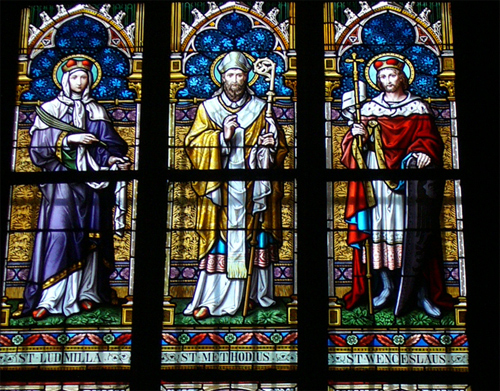 Other windows depicted saints of the Church. Here we see the Saints Ludmilla, Methodius and Wenceslaus.
Other windows depicted saints of the Church. Here we see the Saints Ludmilla, Methodius and Wenceslaus.
 In this window we see the Saints Adalbert, Cyril and Clemens.
In this window we see the Saints Adalbert, Cyril and Clemens.
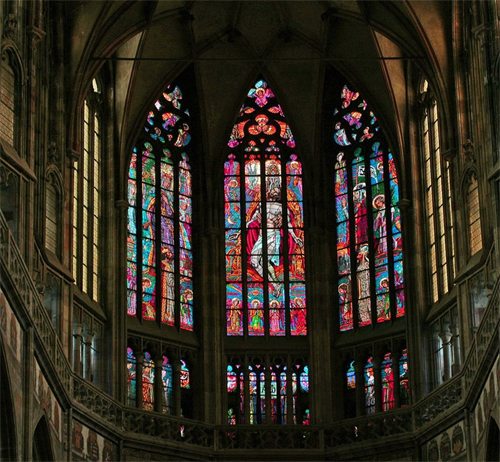 The large stained glass windows at the end of the cathedral.
The large stained glass windows at the end of the cathedral.
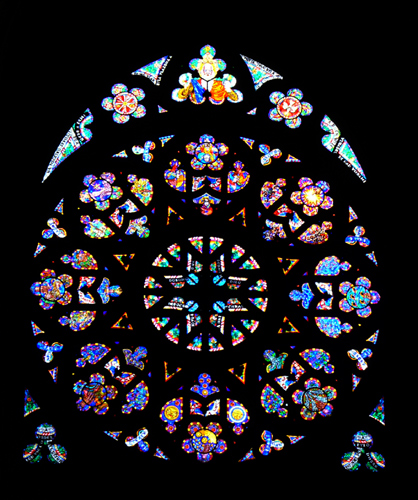 The rose window is a beautiful example of stained glass craft in Prague. It is rather new, dating from the 1920s and represents scenes from the biblical Creation.
The rose window is a beautiful example of stained glass craft in Prague. It is rather new, dating from the 1920s and represents scenes from the biblical Creation.
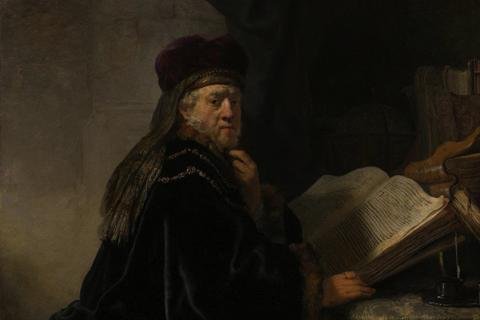
After we finished looking around the castle area, we went to the Sternberg Palace which had a special exhibition called Rembrandt and Co., which had a whole floor of works by Rembrandt and his students and contemporaries. We had expected to see Rembrandt's Scholar in His Study there since it is in their collection.
But we did not expect to see it shown next to Bust of a Man in an Oriental Costume. These were paired in this way because the same model was used in both paintings.

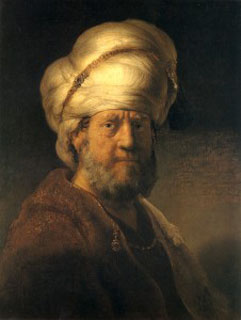
Another example was the pairing of two paintings by one of Rembrandt's students, Govert Flinck. He painted Rembrandt as a shepherd and his wife Saskia as a shepherdess.
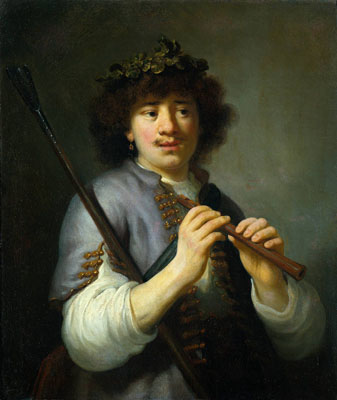
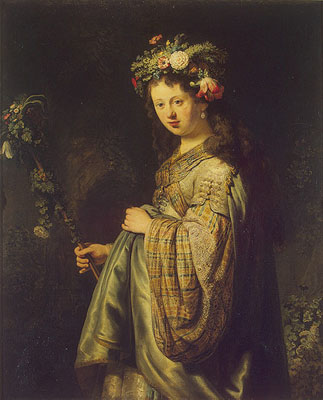
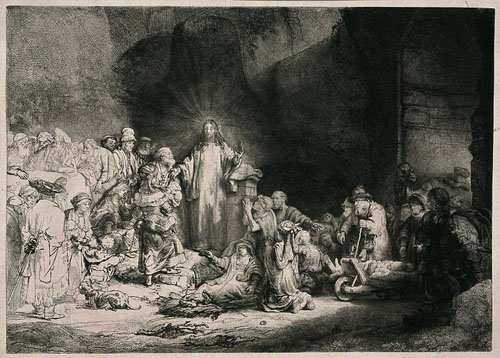
Another outstanding work in this exhibit was Rembrandt's Hundred Guilder Print, borrowed the the Rijksmuseum in Amsterdam.
After a couple of hours there, we walked down the hill and looked around the Old Town Square a bit and then took a tram to our hotel. There we had a farewell drinks with the other tour members who were leaving for home or trip extensions the next day.

Since we were staying in Prague two more days, we had a leisurely breakfast at the hotel the next morning and then went to an apartment between the Old Town Square and the Charles Bridge. We stayed in the first floor apartment above the Black Star Restaurant.
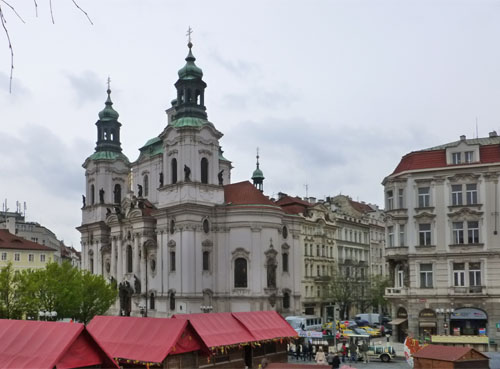
One of our first outings from there was to the Old Town Square. The red roofs in the square were coverings for booths used in the Easter festivities of the previous weekend. In this direction we see the baroque Church of St. Nicholas.
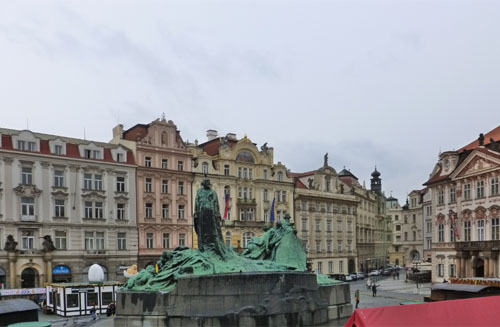
To its right we see the memorial to Jan Hus, which we will talk about later.
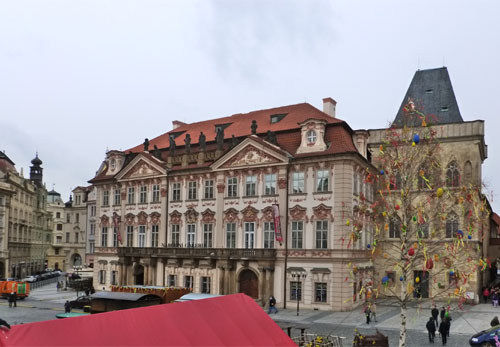
Here we see the Kinsky Palace. Note the Easter eggs in the tree in the foreground.
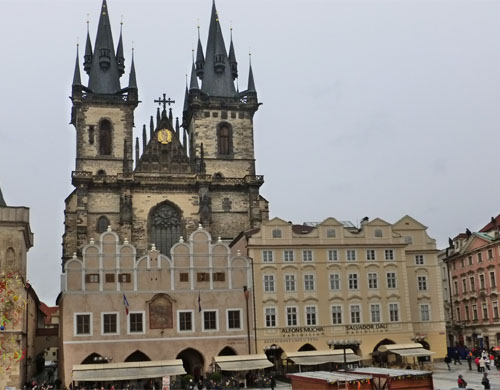
Still further around the square, we see the Church of Our Lady Before Tyne, which we will also mention later.
 Here we see the Town Hall Tower.
Here we see the Town Hall Tower.
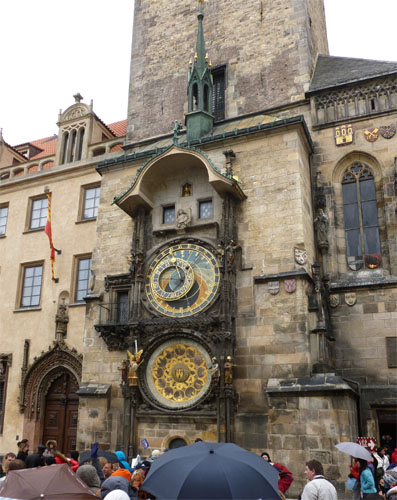
A bit later, we walked to the side of the tower, where we saw the 15th century Astronomical Clock.
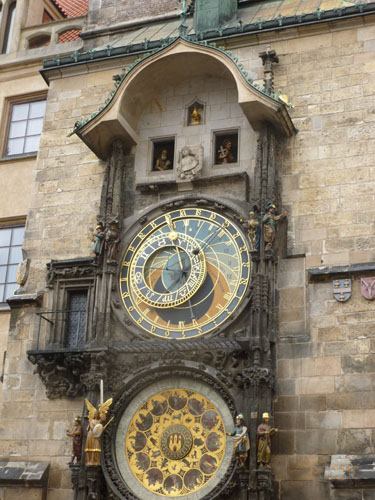 On the hour, the skeleton at the right of the clock rings a bell and the two windows at the top open and the 12 apostles (actually 11 apostles plus St. Paul) appear before the clock chimes.
On the hour, the skeleton at the right of the clock rings a bell and the two windows at the top open and the 12 apostles (actually 11 apostles plus St. Paul) appear before the clock chimes.
To better understand Prague, we now give some some of the history of the reformer, Jan Hus. He followed the teaching of John Wycliff, who translated the Bible into English in 1382. Both advocated the right of the common man to read the Bible in his own language. Both Wycliff and Hus believed scripture to supersede the dogmas and ordinances of the church. Hus especially questioned the use of indulgences and the Catholic mass, where the laity could eat the bread but only the priest was allowed to drink the wine from the cup or chalice. For this he was burned at the stake on July 6, 1415.
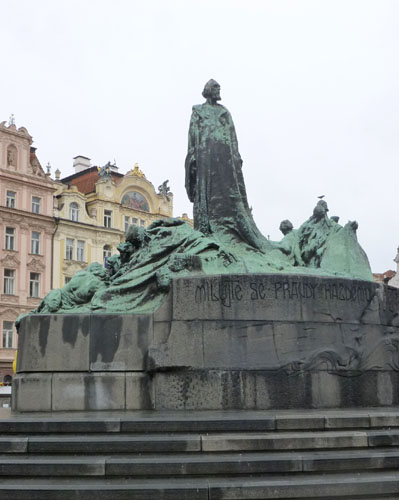
His movement also had political implications, involving the Czechs against the Hapsburgs, and moral implications, regarding the poor against the rich. For these reasons, Jan Hus is still a national hero today in the Czech Republic even though most Czechs describe themselves as non-religious, and among Christians there are more Roman Catholics than Hussites. July 6, the anniversary of the execution of Jan Hus, is still one of the public holidays in the Czech Republic.
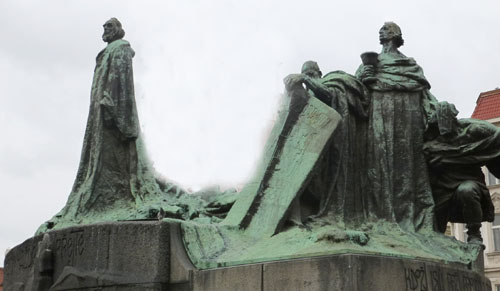 On the right we see one of his followers holding the chalice or cup.
On the right we see one of his followers holding the chalice or cup.

On the back are the families devastated by the killing of the Hussites.
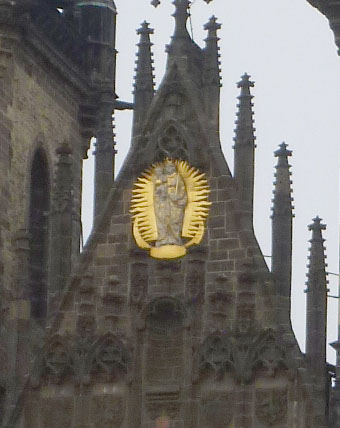
A part of this history includes the Church of our Lady before Tyn. Construction of the present church started in the 14th century in late gothic style. At the beginning of the 15th century, construction was almost done; only the towers, gable and roof were missing. The church was controlled by Hussites for some time, and during this time the roof was completed, while the gable and northern tower were completed shortly thereafter. On the gable was placed a huge golden chalice, the symbol of the Hussites. The southern tower was not completed until 1511. In 1626, after the Battle of the White Mountain, where the Hussites were defeated, the chalice was melted down and replaced by a sculpture of The Madonna, made with gold from the chalice.

One last item about Jan Hus. This is a reconstruction of the Bethlehem Chapel where he preached.
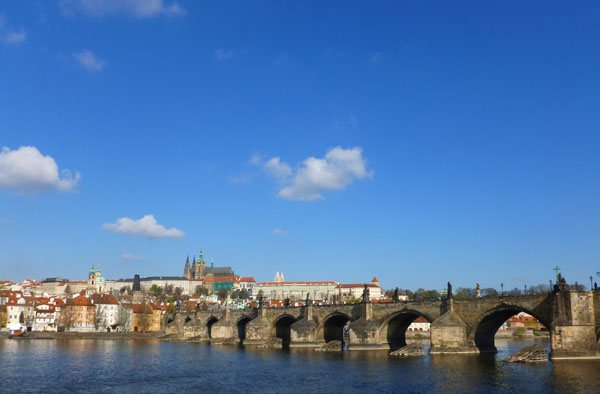
The next day turned out to be a beautful sunny day and we took advantage of it with a walk along the river. Here we see most of the Charles Bridge and the Castle.

A telephoto shot of the Castle.
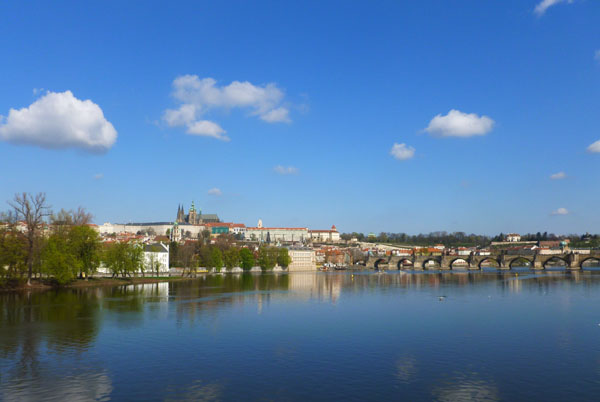 Another view of the river.
Another view of the river.
The Old Town Bridge Tower and one of the 30 statues on the Charles Bridge.
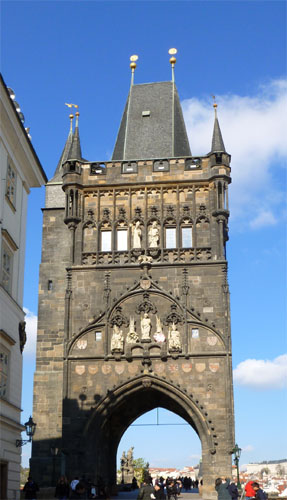

A statue of St. Vitus and the Little Quarter Bridge Tower at the other end of the bridge.
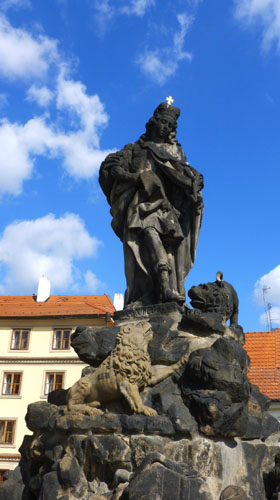
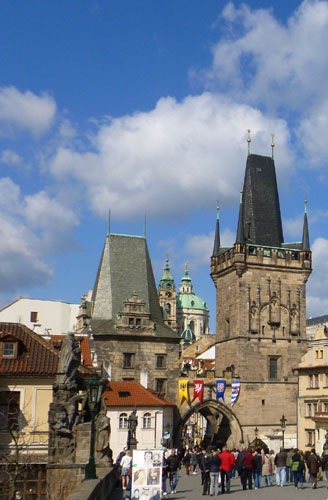
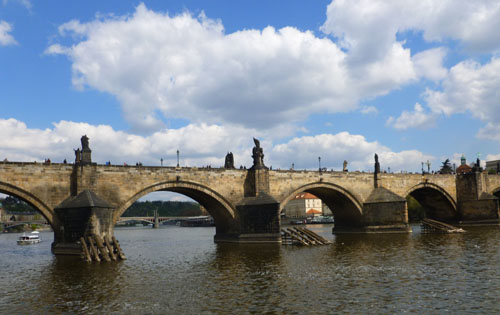
It was a beautiful day for a river cruise. From there we saw the Charles Bridge from a different angle.
 Another view of the bridge with the Old Town Bridge Tower on the right.
Another view of the bridge with the Old Town Bridge Tower on the right.
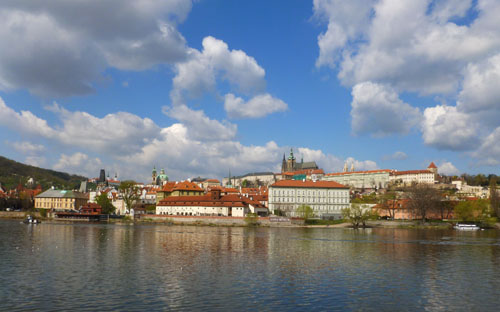 There was also a great view of the river, the castle and the clouds.
There was also a great view of the river, the castle and the clouds.
 We had to check out some of the modern city of Prague. Here are the large stores in Wenceslaus Square.
We had to check out some of the modern city of Prague. Here are the large stores in Wenceslaus Square.

The next day we flew home to San Diego with great memories of rivers, Rembrandt, the Reformation and reunification (of East and West Germany).